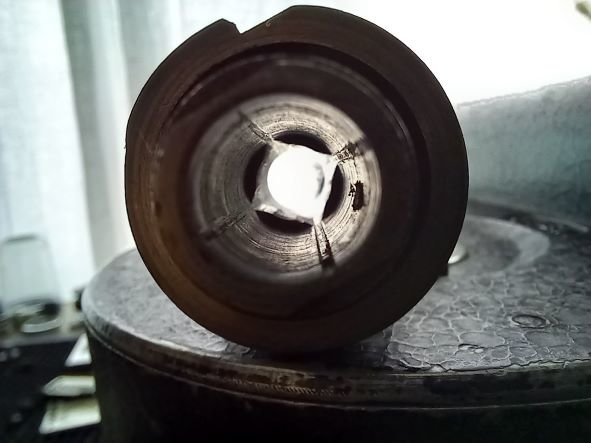-
Posts
2,588 -
Joined
-
Last visited
Everything posted by Simon Wyss
-
No, I'm not. Are you from India? LVSVM . . . I've got the information from Mr. Haas, former sales head at Agfa-Gevaert headquarters. It is somewhat outdated and could have been exaggerated already at the time, so in need of an update. I think you'll find an ear with Agfa India private Ltd., Bombay, a 100 percent daughter of Agfa-Gevaert, Mortsel.
-
Great pixilation!
-

How to do a negative cut?
Simon Wyss replied to Maximilian Schmige's topic in Film Stocks & Processing
High, Karl You're stating Film Loader, hihi. No slope was intended. I was brought up very rudely in the sixties. I know I must get rid of some tone. Still, a bunch of us started to teach the initial poster instead of encouraging him. Why not let him find out himself? I thought it's such a rare incident that someone dares simply picking up the existing. -
Please excuse everyone, I'm after words, alright? Language. Terms. Who says, a film is sharp? No professional does. We say the picture is sharp or unsharp. Friends, we are far away from measurements, graphs and calculation. It's Kodak who publish rubbish and a colleague who wants to hear our opinion. Unfortunately, we have become accustomed to that kind of ad texts. Rochester, try not to babble!
-

How to do a negative cut?
Simon Wyss replied to Maximilian Schmige's topic in Film Stocks & Processing
Racist? You mean chauvinist. The translation part is funny. -

How to do a negative cut?
Simon Wyss replied to Maximilian Schmige's topic in Film Stocks & Processing
Max, laß dich von den Angelsachsen nicht einschüchtern, jeder kann sein Negativ schneiden und montieren. Das beste Gerät baut Ernst Hammann, Amorsbach. Ich kann dich mit Filmkitt versorgen, dem einzigen Produkt, das keine nieren- oder leberschädigenden Dämpfe abgibt, nicht cancerogen ist und langsam bindet. Es stinkt nur nach Essig und heißt PARATAX. Gerne säße ich mit dir in dem alten Schneideraum als Assistent. Max, don't let yourself be awed by the Anglosaxons, everyone can cut and splice his negative. Hammann builds the best equipment. I can furnish you with film cement. I'd like to sit in that old editing room with you as assistant. -
No, Dominic, the initial question is That is crap. Do tell me what a sharp film is besides sex. The terms have come up, acutance, mathematics, but there is no discussion of such things as long as the picture is out of focus. Sharpness has to do with lenses, focus.
-
Rubbish. The term sharpness belongs to optics, nothing else. Photographic layers are discussed under the aspect of resolution, resolving power. There is nothing sharp or unsharp about a film. A lens is focused, the more or less clear image is called sharp or unsharp. A shame that Kodak folks jumble words like laymen.
-
Right guess. Spools for Double-Eight film are specified by ISO 1020, sizes 25 ft, 50 ft, and 100 ft. They have 3- and 4-splined spindle holes.
-
I have introduced Gigabitfilm 40 to cinematography in 2001 (35 mm), in 2005 (16 mm). We have shot with an Arriflex BL II, with a Paillard-Bolex H 16 S, and other makes. Its finest application is as a duplicating stock. Also, it served me well with variable density sound work. A gamma as low as log 0.4 is feasible. There's a machine version of the original developer under way. I did all processing by hand until 2008. www.gigabitfilm.de
-
ISO 1019 specifies daylight loading type spools for 16 mm motion-picture film cameras, there is also the 50 foot size. http://www.filmdex.com/film_11.shtml
-
That's correct but no more for black and white. A sharp negative has been exposed behind a lens, and everything after the negative actually should deal with that lens' geometry. That is why a good contact positive correctly projected outperforms any positive derived from data out of the same negative. But I am leaving the reversal issue.
-
Agfa have around 80 percent of the India cinema print market.
-
I know the beast. What's up?
-
Not so. Fomapan R 100 is produced and marketed by Foma Bohemia, Ltd., of Hradec Králové, Czech Republik. It is available as 35-mm. film, 16-mm., Double-8, and Double Super-8. Then there is Kahl of Brühl in Germany who sells an E-6 process colour reversal stock in Double-8, along with more stuff. Then you have Wittner in Hamburg who offer different makes. Then you have Gigabitfilm 40 which will become available also in Double-8 in summer 2011. http://www.foma.cz/ http://www.wittner-kinotechnik.de/home.php http://www.kahlfilm.de/ http://www.gigabitfilm.de
-
Thank you, John, you give it in exactness better than I do.
-
There are movie stocks on the market that are meant to be developed after the E-6 process. E-6 has evolved from the older E-4 and the still older A-2 process of Agfa. There is the historical fact of forcedly published patents such as with Agfacolor in 1945. Eastmancolor derives from Agfacolor (1950). Motion-picture colour film of today is hardly comparable to these systems. Chemistry has been changed, too. An E-6 process film will not stand up to properly treated colour negative and positive after ECN-ECP, an ISO speed value given for both sides.
-
Why this mincemeat? I must say that I could not see anything like editing out of the pictures' rhythm, development from a given pace outwards. You chop up everything. Why?
-
Nick, I’ve just read your initial question, ...now what is the 'bolex' of 35mm ?, and should like to add that there was a 35-mm. film Bolex. Its name was Cinégraphe Bol and it’s been on display at the 1923 Geneva national exhibition. Jacques Bogopolsky and Charles Haccius together legally owned the trade mark Bolex from 1924 on. This Cinégraphe flopped entirely. It has a a double side five claw movement, a drum shutter, fixed lens, peep-sight parallax viewfinder, crank and screw-on clockwork drive. My theory is that this Haccius made a deal with one of the U. S. companies after the total failure of the Bol company in 1929-30. The Paillard-Bolex H cameras are not swiss, not Bogopolsky’s design. Possibly Rochester, perhaps Chicago
-
There is an antique school way of recording with wild cameras. You record the noise of the camera on a separate track, be it on tape, be it digitally. You will hear the camera whir exactly as long as the picture runs and from that be able to determine beginning and end of the synch section.
-
To produce a black-and-white motion picture film is a confession. What are you talking about with post production, digital hiphop, and negative contrast ranges? You light a black-white totally different. You draw the story rather than paint it. The relation between picture and sound is different, too. Polenta or popcorn
-

Workprint vs. Answer Print vs. Release Print
Simon Wyss replied to Satsuki Murashige's topic in Film Stocks & Processing
A lab with unsharp prints is not viable. Soft copy doesn't sell. What is possible is that the answer print in question has been a so-called wet print, i. e. a positive derived under a liquid. Most work prints, rushes, dailies are dry copy. Negative and raw stock come together partially around a toothed drum of 64 perforations circumference. Both films run onto the drum under some tension and leave the same in a slack with no tension. It's virtually impossible that the print comes out unsharp. A bit critical it is with step printers but I'd like to say that there, too, all lab folks are very well aware of their equipment and what comes out of it. Could be as an other possibility that there were different lenses in use for projection. You may want to check this before more investigation. Believe me, sometimes it is only a ridiculously small thing to trouble big minds. -
One can enter Foma Bohemia's shop in Prague, Jungmannová 2, any time of the year and buy Fomapan R 100 in Double Super 8 and lengths of 33 or 100 foot. Gigabitfilm will be available in Double-Eight and Double Super 8 towards end 2011.
-

Slates: Black and White vs. Color
Simon Wyss replied to Nolan M Berbano's topic in Camera Assistant / DIT & Gear
Hey, where the film did you learn German?


